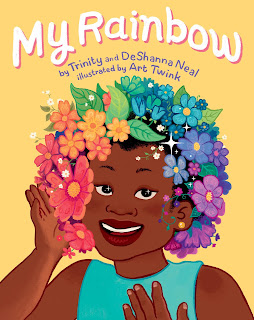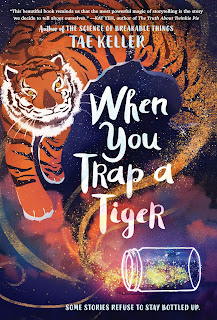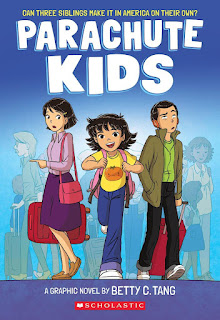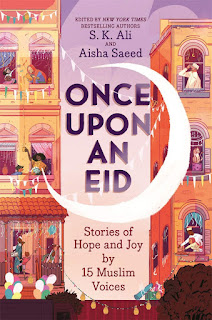#IMWAYR: Picture Book Pandemonium, Part 9!
(Update: I wanted to announce that I'm participating in #MustReadIn2022 this year! Click here to see what I'll be reading.)
My Rainbow
Written by Trinity Neal and DeShanna Neal
Illustrated by Art Twink
A little over a year ago, Lisa Maucione at Literacy on the Mind recommended this book, and I would have read it a lot sooner except that my library just recently added it on Libby. So I finally read it now, and it is great!!!
The authors of My Rainbow, DeShanna and Trinity Neal, drew from their own experiences to create this story—like in the book, Trinity is a teenage transgender girl on the autism spectrum, and DeShanna is her mother who has become an advocate for transgender rights. If you want more info about these two, this article about the Neals in Delaware Today is quite interesting and thorough (although it does appear from Amazon that DeShanna Neal now uses they/them pronouns, so ignore that part of the article.) My Rainbow opens with Trinity enjoying herself spending time with her big family (including three younger siblings and an adorable pet pig—and yes, they have a pet pig in real life!). But Trinity grows frustrated and, with the help of her mom, explains that she needs to have long hair (in part because of the expectations for transgender girls). Trinity's mom knows that Trinity would be uncomfortable if she actually grew her hair out (it's implied that this is because of her sensory sensitivity)—but maybe there's another way. So Trinity's mom, with the help of her family, sets out to get Trinity the long hair that she needs...and hopefully will love too!
This is an absolutely wonderful story for so many reasons! First of all, if you saw my recent 2021-in-review post, you know that I was a little disappointed that I had not read any picture books in 2021 with LGBTQ+ representation (and that I had read very few books at all with representation of neurodiversity). So I was thrilled that this book carried me a little bit further on both goals by bringing such meaningful representation to the table! Without getting too complicated for a young audience, this book touches on elements of Trinity's experiences of being transgender (such as her feelings that, where cisgender girls could get away with shorter hair, she cannot) and of being on the autism spectrum (such as her sensory sensitivity)—I can imagine this book being a wonderful way to start conversations with young readers about these concepts. But what's most impactful of all is seeing the love that bonds this family together—Trinity's mom (and her siblings too!) are prepared to do whatever it takes to make her feel comfortable in her own skin. The scenes at the beginning of Trinity and her siblings playing dolls together not only set up the story nicely, but also further develop the sense of family and love that is at the core of this book. The story's narration has an endearing tone and strikes a delicate balance between bringing up topics and not being preachy, and the illustrations by Art Twink are perfect—the cartoonish yet detailed style, the full rainbow of bright colors (fitting for this book!), the fun details embedded in each spread, and the varied mix of realistic and inventive page layouts all take this book to the next level. It definitely would have been possible to write this book in a preachy, slow, or overly complicated way, but the genuine joy and love that radiates through every sentence and every illustration of this story makes it not just a meaningful exploration of diversity, but a meaningful exploration of family and motherly love too!
Written by Jamilah Thompkins-Bigelow
Illustrated by Luisa Uribe
Way back when I joined #IMWAYR, I recall this book making the rounds (and I know Cheriee Weichel at Library Matters recently enjoyed it as well), but only recently did my library finally add a copy on Libby. And since I was already acquainted with Jamilah Thompkins-Bigelow's writing (from the MG anthology Once Upon an Eid) and Luisa Uribe's illustrations (from the picture book Areli Is a Dreamer), I finally borrowed this book and read it, and I'm glad I did!
The protagonist of Your Name Is a Song is frustrated on her first day of school—no one knows how to pronounce her name (including her teacher), and some of the other kids even make rude comments about it. But on the walk home from school, her mother shows her that every name is beautiful, fierce, creative, melodic—a song. And with that renewed confidence, our protagonist returns to school ready to show others the beauty of her song and others.
I realize that's a vague summary, but I don't want to give too much away—just know that this is an absolutely lovely story! Just like in the book above, motherly love plays a major role in this story—it is lovely to see the girl sharing what happened at school with her mother as her mother works to show her (in the most fun way possible!) why each of those things doesn't mean there is anything bad about her name. The different unpleasant moments at school and how meaning is made out of each reminded me a little bit of The Day You Begin (which is also a first-day-of-school story), although this book does not depict each moments, but rather simply responds to them in some truly ingenious ways. The comparison between names and songs has some deeply meaningful subtext that comes through in the story—in the front and back matter, there are mentions of griots (or "someone who passes on oral history through song," per the back matter") inspiring the story, and I would imagine being familiar with that tradition would add even more depth to the idea of sharing the songs of our names with others! Also, I was impressed by Thompkins-Bigelow's compassion and restraint in making this story truly inclusive of everyone—characters of all races (including White) have their names celebrated, and even characters who are really quite in the wrong (like the teacher, who really should have been able to pronounce our protagonist's name—it is revealed toward the end, and it's not hard) are ultimately given space to learn and grow. These moments emphasize that the end goal is not for one group to regain confidence and "win" over another, it is for all groups to be confident and proud and to come together and share their beauty with one another. Which is awesome! Luisa Uribe's illustrations are beautiful and joyous, with bright pastel colors, a lovely mix of realistic backgrounds and decorative bursts and lines, and radiant facial expressions that help this book shine. And as one final note, the pronunciation guides within the story for each name, as well as the glossary in back with etymologies of each name, further allow every reader to celebrate the names contained in this book. Overall, this story is a joyous, inventive, and beautifully illustrated depiction of what happens when we not only understand our names, but also share their beauty with others!
Written by Matt de la Peña
Illustrated by Christian Robinson
I had a vague sense of this book existing, considering that not only is it a Caldecott Honor Book and a Coretta Scott King Illustrator Honor Book, it's also a Newbery Medal winner. That last bit is the most shocking, because the Newbery Medal is "technically" for the best of children's literature but is generally an award for MG books specifically, so seeing a picture book not just being selected, but winning is quite surprising. And yet, I still hadn't gotten around to reading it until an excellent new recruit at #IMWAYR, Linda Browne (who posts reviews at Bookcase Bizarro), also recommended it! And I appreciated her nudge to try it out, because this book is (unsurprisingly) fantastic!
In Last Stop on Market Street, CJ and his Nana get on the bus for their weekly trip across the city, but CJ is full of questions. Why don't they have a car to drive, instead of taking the bus? Why doesn't he have a music player like those other kids on the bus have? But question by question, CJ's Nana shows him that life isn't about the things we could have, but about the beauty in the world around us, and the people in our community who we connect with or give back to.
I wasn't expecting this book to stand out particularly from the many other picture books I've read, but (surprise, surprise) it actually did, and I can see why it has been so widely recognized! I definitely don't imagine this is the first book to have a child wondering why his life is different from the lives of those with more money, but I do imagine this is the book where the adult in said child's life has the most convincing answers. CJ's Nana seriously has a beautiful answer to everything, to the point where this book barely even reads as a child wishing for this or that and more as a sheer celebration of living a life connected to the community around you. With his Nana's help, CJ learns to appreciate the bus ride, the man sitting across from him playing a song on the guitar, even the somewhat-decrepit neighborhood where he and his Nana arrive for what turns out to be volunteering to help others in the community. (Speaking of which: although it isn't really discussed directly, there's something very meaningful about a family who, at the very least, isn't wealthy nevertheless giving back to those less fortunate than themselves.) Matt de la Peña's narration is unusually well-written for a picture book, with some lovely and lush moments of description and distinct voices for both CJ and Nana. And Christian Robinson's illustrations are excellent, with a sketch-style quality (that is 100% the wrong term, but I'm not well-versed in art at all), vivid colors in countless shades, and varied layouts—they lend energy and fun to the story that will appeal to kids, but their craft will appeal to older readers as well. (Am I making any sense at all? I'm so tired.) Overall, the themes of connecting with community, giving back to others, and living a life full of beauty regardless of income/class add countless layers and opportunities for discussion to this energetic, lively story—I think the highest praise I can give is that I appreciated the moments in this story as much as CJ learns to!
Written by Nikole Hannah-Jones and Renée Watson
Illustrated by Nikkolas Smith
(A quick note: I meant for this review specifically to be part of another post, so the format is slightly different because, starting next week, I will be beta-testing a slightly-different review format that is hopefully a little bit faster to read. But this beta test didn't work well, because as you can see, it's longer than the reviews above! But since this book is my favorite of the week, I suppose that's fine. So let's take a look!)
A quick bit of backstory before we dive in: as I was actually just learning about in a college class this semester, The 1619 Project is an initiative through the New York Times led by Pulitzer Prize-winning journalist Nikole Hannah-Jones to reframe American history as beginning in 1619, when the first slaves were brought to America (even before the Mayflower arrived, as this book points out).
As part of the project, Hannah-Jones cowrote this haunting, eye-opening, and ultimately hopeful picture book with the extremely prolific Newbery Honor-winning kidlit author Renée Watson—if her name sounds familiar, check out her books here (the most recent books of hers I've heard discussed are Love Is a Revolution, Ways to Make Sunshine, and Ways to Grow Love). (Also, I must admit I've never actually read any of Watson's books until now, which is pretty embarrassing.)
I saw this book recommended by Beth Shaum at A Foodie Bibliophile in Wanderlust, Ricki Ginsberg at Unleashing Readers, Sierra Dertinger at Books. Iced Lattes. Blessed, and Linda Baie at TeacherDance, so I finally got it read, and I'm so, so grateful that I did!
When this story starts out, the protagonist is frustrated that, for a school assignment about her ancestry, her classmates can go back countless generations, but she only knows three generations back, all in the United States. So our protagonist's grandma tells her the story of her ancestors, who were torn from their vibrant culture and their families and brought to the United States by force, but who resisted, formed a new culture and passed it down, and above all else, kept their hope.
I think many of us have some kind of understanding of the facts of slavery. But what Born on the Water brings to life is the feelings. I felt more reading this story than I felt over the course of several years learning about slavery in school (although since the instructors teaching it to me were all racists, I guess I shouldn't be surprised). So what did I feel?
Well, I felt the pain of understanding that the people who were enslaved didn't start out being enslaved. They started out free. They had cultures and families and skills and livelihoods, and this book has several spreads and poems that bring those elements to life. And then all of that was torn from them—or at the very least, was supposed to have been torn from them, if it were completely up to their captors. It's easy to think that slaves lived in this endless amount of hopelessness that they were just used to. And that is so completely false—these individuals lived lives of hope and joy and love and then had that ripped from them, and they felt the acute sense of loss that having your entire livelihood destroyed would do to you.
And speaking of that false idea about getting used to hopelessness, reading this book showed me that enslaved people did not cope with their conditions by getting used to hopelessness either. Hannah-Jones and Watson's gorgeous poems make clear that what helped these people survive their conditions wasn't about hopelessness at all—it was about hope. And how did these people have hope? Because, in spite of their conditions, in spite of being separated from those of their actual culture or nationality, in spite of being separated from their own families...they weren't separated from each other. Held in absolute squalor on the ships taking them to the United States, these individuals who did not know one another were brave enough to come together and form a new culture...one that was born on the water, per the book's title. And along the way, these individuals found ways to resist, to pass down their culture to new generations...to find actual hope. (And, thankfully, it wasn't a hope that was misplaced—for all we still need to fix, slavery as depicted here actually did end.)
OK, I've actually talked more than I do in a normal picture book review (so much for my new shorter format), so I'll save some of the things I really wish I could discuss for you all to actually discover when (not if) you read this book. But I will just say that Nikole Hannah-Jones and Renée Watson's poems that make up this story are absolutely beautiful and evocative and horrifying, but in a necessary and valuable way. And Nikkolas Smith's illustrations are unlike anything I've seen in a picture book before—their painted style and haunting but gorgeous contents truly bring this book to life, which isn't exactly a fun thing, but is a necessary thing. I am grateful that Born on the Water is a picture book, because the simplicity of the format brings out the emotions of the story all the more—and the emotions are not just what readers will actually remember, they are what readers need to remember, because they are the force that actually effects change in this world. This book is an absolute must-read for any picture book reader—or really, for any person, period.
That's what I've been reading recently—I hope one of these picture books speaks to you!
My favorite book of the week: The 1619 Project: Born on the Water
Oh, and one more thing...
Fast-forward to the present day. I'm checking my email inbox, clicking through the many marketing emails that Apple sends for, and I get to the one for Apple TV+ and OMG IS THAT AN EL DEAFO SHOW???!!!
And yes, it is! Apple TV+ worked with Cece Bell herself to adapt El Deafo into a three-part animated miniseries that came out on Friday! I just watched the first episode on Friday night, and although the episode got off to a slightly rocky start, by the end, I was as hooked as I was when I read the book. Because Cece Bell was actually involved in writing it, it's faithful down to the smallest details, and Bell herself actually provides voiceover narration that sets the scene when young Cece can't quite explain things herself. Speaking of young Cece, she's actually voiced by a deaf individual, Lexi Finigan, which is really nice to see. And there's original songs (which have also been released as a soundtrack), and the animation style actually matches the illustrations in the book, AND you actually hear the dialogue in the ways that Cece herself would hear it with her hearing aids (or wouldn't hear it, as you'll see happens when she can't also lip-read), which is really eye-opening and probably one of the best uses of a TV/movie adaptation I've seen in conveying something the book can't. (Bell mentioned on her blog that the sound design was done by the people who did it for A Quiet Place—I haven't seen that, but I've heard that the sound design is really impressive there too, so that might impress some of y'all!) In short, you should be excited, particularly if you're a huge fan of the actual book like I am, and you should head over to Apple TV+ and check it out! (And there might be other stuff on Apple TV+ worth noting too—I was on their newsroom page and saw they have an adaptation of Harriet the Spy—so you might see what's on offer there!) (Update: Now it's Sunday night, and I just finished the last episode of El Deafo, and I figured I'd share that it only got better as it went on—I am so glad it exists, and please do take the time to watch it!)








Thanks for the shout out! Glad you finally got to read My Rainbow. I didn't know about El Deafo being made into a show. It sounds great!
ReplyDeleteThanks for your review of The 1619 Project: Born on the Water. While I knew about this book, I hadn't really done anything about it. You convinced me to read it. I checked and discovered my library has the ebook available and the hardcopy book on order. I am still deciding if I should wait or????
ReplyDeleteThanks for all these reviews. I've added My Rainbow to my list.
Oh I love all of these books for different reasons. They are all so powerful in their own way!
ReplyDeleteWe don't have AppleTV. With everything else... it's on the one channel we don't have, ugh!
My older granddaughter has loved Cece Bell's book so I will tell her about the show. How wonderful! I'm glad you enjoyed Born on the Water, so, so wonderfully done & needed. I still have Last Stop on Market Street, an old favorite. And I bookmarked My Rainbow, wishing I would have had books like that when teaching. Through the final years, I had two who were preparing to trans & needed to "see" themselves in stories. Thanks a bunch!
ReplyDeleteI definitely remember enjoying Last Stop on Market Street - probably worth a re-read on my part! And I know what you mean about Newbery and how surprising it is when a picture book wins or takes an honor. I felt the same way when Crown: An Ode to the Fresh Cut took an honor (which I heartily recommend). It's just one reason why Elisabeth and I have our Children's Literature students study the criteria committee members must consider for each award before selecting winners/honors. And I absolutely can't wait to read The 1619 Project: Born on the Water. We don't yet have it at any of my libraries, but very soon I'm sure. And I MUST to get back to El Deafo. A couple years back I had it checked out from my college library for months and ended up having to turn it back in before finishing. I'd love to read and compare the book to the series. Thanks for sharing, Max! (Checking in late - I had to miss posting last week for several reasons, but I plan to be back this week).
ReplyDelete